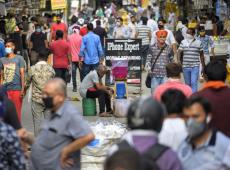India's Hindu Population Declines, Muslim Population Rises: EAC-PM
By Rediff Money Desk, New Delhi May 09, 2024 14:15
A new study by the Economic Advisory Council to the Prime Minister (EAC-PM) reveals a decrease in India's Hindu population and an increase in the Muslim population between 1950 and 2015. The report suggests a conducive environment for diversity in India.

New Delhi, May 9 (PTI) The share of the Hindu population decreased by 7.82 per cent between 1950 and 2015 in India, while that of Muslims increased by 43.15 per cent, suggesting that there is a conducive environment in the country to foster diversity, said a recent working paper by the Economic Advisory Council to the Prime Minister (EAC-PM).
The paper titled 'Share of Religious Minorities: A Cross-Country Analysis (1950-2015)' further said the share of Jains in the population of India decreased from 0.45 per cent in 1950 to 0.36 per cent in 2015.
"... The share of the majority Hindu population decreased by 7.82 per cent between 1950 and 2015 (from 84.68 per cent to 78.06 per cent). The share of Muslim population in 1950 was 9.84 per cent and increased to 14.09 per cent in 2015 -- a 43.15 per cent increase in their share," said the paper prepared by a team led by Shamika Ravi, member, EAC-PM.
According to the paper, the share of Christian population rose from 2.24 per cent to 2.36 per cent -- an increase of 5.38 per cent between 1950 and 2015.
While the share of Sikh population increased from 1.24 per cent in 1950 to 1.85 per cent in 2015 - a 6.58 per cent rise in their share, the share of the Parsi population in India witnessed a stark 85 per cent decline, reducing from 0.03 per cent share in 1950 to 0.004 per cent in 2015.
The data indicates that "there is a conducive environment to foster diversity in the society," the paper said, adding that it is not possible to promote better life outcomes for the disadvantaged sections of society without providing a nurturing environment and societal support through a bottom-up approach.
The paper noted that a decrease in the share of the majority population and a consequent increase in the share of minorities suggests that the net result of all policy actions, political decisions and societal processes is to provide a conducive environment for increasing diversity in society.
The report pointed out that in keeping with the global trends of declining majority, India too has witnessed a reduction in the share of the majority religious denomination by 7.82 per cent.
"This is particularly remarkable given the wider context within the South Asian neighborhood where the share of the majority religious denomination has increased and minority populations have shrunk alarmingly across countries like Bangladesh, Pakistan, Sri Lanka, Bhutan and Afghanistan," the paper said.
The paper said it is not surprising, therefore, minority populations from across the neighborhood come to India during times of duress.
It pointed out that all the Muslim majority countries witnessed an increase in the share of the majority religious denomination except Maldives, where the share of the majority group (Shafi'i Sunnis) declined by 1.47 per cent.
In Bangladesh, there was an 18 per cent increase in the share of the majority religious group which is the largest such increase in the Indian subcontinent. Pakistan witnessed an increase of 3.75 per cent in the share of the majority religious denomination (Hanafi Muslim) and a 10 per cent increase in the share of total Muslim population despite the creation of Bangladesh in 1971.
According to the report, among non-Muslim majority countries, Myanmar, India and Nepal saw a decline in the share of the majority religious denomination.
The paper noted that the year 1950 is important as a baseline year for two major reasons.
This was around the time that the international human rights framework under the aegis of the newly created United Nations began to take shape with minority rights and state responsibility for protection of minorities being mainstreamed in international law, the paper said.
The paper is a detailed cross-country descriptive analysis of the status of minorities around the world measured in terms of their changing share in a country's population over 65 years between 1950 and 2015.
For the 167 countries analysed, the average value for the share of the majority religious denomination in the baseline year of 1950 is 75 per cent, while the mean of the distribution capturing the change in majority religious denomination between 1950 and 2015 is 21.9.
The paper titled 'Share of Religious Minorities: A Cross-Country Analysis (1950-2015)' further said the share of Jains in the population of India decreased from 0.45 per cent in 1950 to 0.36 per cent in 2015.
"... The share of the majority Hindu population decreased by 7.82 per cent between 1950 and 2015 (from 84.68 per cent to 78.06 per cent). The share of Muslim population in 1950 was 9.84 per cent and increased to 14.09 per cent in 2015 -- a 43.15 per cent increase in their share," said the paper prepared by a team led by Shamika Ravi, member, EAC-PM.
According to the paper, the share of Christian population rose from 2.24 per cent to 2.36 per cent -- an increase of 5.38 per cent between 1950 and 2015.
While the share of Sikh population increased from 1.24 per cent in 1950 to 1.85 per cent in 2015 - a 6.58 per cent rise in their share, the share of the Parsi population in India witnessed a stark 85 per cent decline, reducing from 0.03 per cent share in 1950 to 0.004 per cent in 2015.
The data indicates that "there is a conducive environment to foster diversity in the society," the paper said, adding that it is not possible to promote better life outcomes for the disadvantaged sections of society without providing a nurturing environment and societal support through a bottom-up approach.
The paper noted that a decrease in the share of the majority population and a consequent increase in the share of minorities suggests that the net result of all policy actions, political decisions and societal processes is to provide a conducive environment for increasing diversity in society.
The report pointed out that in keeping with the global trends of declining majority, India too has witnessed a reduction in the share of the majority religious denomination by 7.82 per cent.
"This is particularly remarkable given the wider context within the South Asian neighborhood where the share of the majority religious denomination has increased and minority populations have shrunk alarmingly across countries like Bangladesh, Pakistan, Sri Lanka, Bhutan and Afghanistan," the paper said.
The paper said it is not surprising, therefore, minority populations from across the neighborhood come to India during times of duress.
It pointed out that all the Muslim majority countries witnessed an increase in the share of the majority religious denomination except Maldives, where the share of the majority group (Shafi'i Sunnis) declined by 1.47 per cent.
In Bangladesh, there was an 18 per cent increase in the share of the majority religious group which is the largest such increase in the Indian subcontinent. Pakistan witnessed an increase of 3.75 per cent in the share of the majority religious denomination (Hanafi Muslim) and a 10 per cent increase in the share of total Muslim population despite the creation of Bangladesh in 1971.
According to the report, among non-Muslim majority countries, Myanmar, India and Nepal saw a decline in the share of the majority religious denomination.
The paper noted that the year 1950 is important as a baseline year for two major reasons.
This was around the time that the international human rights framework under the aegis of the newly created United Nations began to take shape with minority rights and state responsibility for protection of minorities being mainstreamed in international law, the paper said.
The paper is a detailed cross-country descriptive analysis of the status of minorities around the world measured in terms of their changing share in a country's population over 65 years between 1950 and 2015.
For the 167 countries analysed, the average value for the share of the majority religious denomination in the baseline year of 1950 is 75 per cent, while the mean of the distribution capturing the change in majority religious denomination between 1950 and 2015 is 21.9.
Source: PTI
Read More On:
DISCLAIMER - This article is from a syndicated feed. The original source is responsible for accuracy, views & content ownership. Views expressed may not reflect those of rediff.com India Limited.
You May Like To Read
TODAY'S MOST TRADED COMPANIES
- Company Name
- Price
- Volume
- IFL Enterprises
- 1.36 (+ 4.62)
- 97785208
- Franklin Industries
- 3.90 (+ 4.56)
- 27678082
- Vodafone Idea L
- 16.24 ( -3.28)
- 21997451
- Indian Renewable
- 258.80 ( -4.94)
- 14296562
- AvanceTechnologies
- 0.91 ( 0.00)
- 11610872
MORE NEWS

Wipro Transfers Stake in Financial Outsourcing...
Wipro Holdings (UK) has transferred its entire stake in Wipro Financial Outsourcing...

Indian Markets Turn Negative After Record Highs
Indian stock markets experienced volatility on Thursday, turning negative after...
ASK Property Fund Invests Rs 190 Cr in...
ASK Property Fund has invested Rs 190 crore in a real estate project being developed by...












 © 2024 Rediff.com India Limited. All rights reserved.
© 2024 Rediff.com India Limited. All rights reserved.